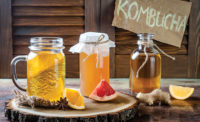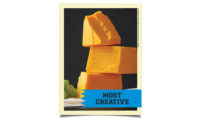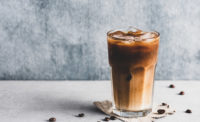The past year has brought good news to some nondairy beverage segments. For example, the cappuccino/iced coffee subcategory saw a 12.1% rise in dollar sales, reaching more than $2 billion, according to data from Chicago-based market research firm Information Resources Inc. (IRI) for the 52 weeks ending Aug. 13, 2017. Unit sales increased by 11.8% to 686.6 million.
Milk | Cheese | Cultured | Ice Cream | Butter | Non-dairy Beverages | Ingredients | Exports
Some other segments weren’t so lucky. Dollar sales in the refrigerated blended fruit juice subcategory, for instance, fell 8.7% to $307.3 million. Unit sales declined 8.7%, to 100.2 million.
Sugar content impacting juices
The juice and juice drinks category has been challenged to maintain its share of the beverage market as consumers look for products that contain less sugar. As a result, many subcategories lost ground here, the IRI data show (see the chart, page 59).
“Volume sales in the U.S. continued to decline in 2016 as consumers turned away from juices due to concerns about their high sugar content,” stated London-based Euromonitor International in its February 2017 report titled “Juice in the US.”
Still, Euromonitor pointed to areas of opportunity in the juice category, including “raw juices” (unpasteurized), cold-pressed options, fringe juices such as coconut water and other plant waters, and juice smoothies.
“While also affected by a high sugar content, the natural and healthy positioning of these juices has enabled them to prosper, driving up average unit price by 2% in 2016,” Euromonitor stated.
Market research experts note that the FDA’s new Nutrition Facts label — which will update serving sizes to reflect the amount that consumers typically will consume and adds an Added Sugar section under the Total Sugars section — could have an impact on the category.
“The new labels propose separating added sugar from total sugars,” the Euromonitor report states. “Although most juices are high in sugar, if consumers are more easily able to differentiate between products with naturally occurring sugar and those with added sugar, some juice categories may be able to shed some of the perceptions of offering unhealthy beverages.”
On the other hand, the trend toward premium products has benefited the category. A November 2016 report from New York-based Beverage Marketing Corp. (BMC) titled “U.S. Single-Serve Fruit Beverages through 2020” predicts wholesale dollars in the super-premium segment will grow to $3.2 billion by 2020.
As consumers look for less sugar and premium juice products, they’re also demanding products that provide value-added benefits. Innovation within the juice and juice drinks segment will help maintain and further drive consumer interest, market research experts say.
On the value-added front, Tropicana, a brand of Purchase, N.Y.-based PepsiCo Inc., launched Tropicana Essentials Probiotics, a 100% juice with probiotics and no added sugar or artificial flavors, early in 2017. Flavors include strawberry banana, pineapple mango and peach passion fruit. The strawberry banana flavor contains 130 calories, 28 grams of sugar and 1 gram of protein. The juice comes in multi- and single-serve sizes.
Tea riding health and wellness trend
A natural health halo has been benefiting the tea category as consumers look for back-to-nature, better-for-you and functional beverage options. Canned and bottled tea saw a 2.2% jump in dollar sales, according to IRI, reaching $3.6 billion. Unit sales rose a more modest 0.4% to more than 2 billion.
And refrigerated teas posted an impressive 7.2% dollar sales increase to reach almost $1.3 billion. Unit sales rose 5.5% to 582.6 million.
According to “Tea: Spotlight on Bagged/Looseleaf Tea,” an August 2016 report from global market research firm Mintel, tea’s health-and-wellness benefits play a role in a consumers’ decision-making.
“Health-and-wellness benefits are influential to consumers when selecting a tea beverage,” Mintel states. “Nearly all consumers believe in the general health-and-wellness benefits of tea. When it comes to more specific benefits like longevity or therapeutic benefits of those health-and-wellness claims, there is a following by at least a third of brewed-tea consumers.”
Although the overall tea market has remained relatively stagnant, category growth largely is a result of the performance of the ready-to-drink (RTD) tea segment, Gary Hemphill, managing director of research at BMC, noted in Beverage Industry’s June 2017 issue.
Chicago-based Mintel also notes this trend in its report.
“Canned/bottled RTD (ready-to-drink) teas and the smaller refrigerated tea segment experienced healthy growth in estimated 2016, which helped to offset losses from bagged/loose-leaf teas,” it states.
In the June issue of Beverage Industry, Chrystalleni Stivaros, industry research analyst at IBISWorld, Los Angeles, noted that the convenience and portability of RTD teas are drivers for the segment.
“RTD beverages cater to the on-the-go lifestyles of modern consumers and are often found in locations where most impulse purchases are made (e.g., convenience stores and vending machines),” she said.
Premium teas are driving growth for both RTD and loose-leaf/bagged teas, Mintel’s report states. Natural and organic traits also bolster the better-for-you perception of teas.
“Consumers tend to perceive natural and organic products as healthier and [as] better for you than those laden with artificial ingredients,” the Mintel report states. “Approximately one in five consumers find natural and organic claims important to their brewed tea selection.”
Speaking of natural and organic, Numi Organic Tea, San Francisco, recently introduced a line of RTD organic teas in five flavors: black lemon, Jasmine green, Hibiscus red, aged Earl Grey and classic mint. The teas are available in stores in Southern California, Portland and Seattle.
And when it comes to premium RTD teas, real-brewed tea is picking up steam, notes Euromonitor in its February 2017 “RTD Tea in the US” report.
“One of the most-developed premium RTD tea trends is that of real-brewed tea, whereby producers create RTD tea from brewing tea with tea leaves as opposed to the more conventional use of tea extracts or concentrates,” the market research firm states.
Within this space, Pure Leaf, a brand of the Pepsi Lipton Tea Partnership, Purchase N.Y., recently added mint and pomegranate flavors to its lineup of RTD leaf-brewed iced teas. Offered in 18.5-ounce bottles, the teas are available nationwide.
Cold brew coffee is booming
On the coffee front, the cappuccino/iced coffee segment wasn’t the only one with positive news. Although it’s still dwarfed by many other nondairy beverage categories, refrigerated RTD coffee has been picking up steam. Dollar sales within the segment rose 30.5% to $285.1 million, according to the IRI data. Unit sales climbed 29.1 percent to 73.9 million.
Making the most waves in the RTD coffee category overall, perhaps, is cold-brew coffee. The blossoming cold-brew coffee subsegment has helped to increase sales in the RTD coffee category and should continue to grow moving forward, Hemphill said.
New here is Black Label Cold Brew RTD coffee from Los Angeles-based Califia Farms. Packaged in 10.5-ounce amber glass bottles, the cold brew coffee comes in black mocha, signature blend and single origin varieties.
And Uncommon Coffee Roasters, Douglas, Mich., recently debuted an RTD cold brew coffee in a 16-ounce carton. The product comes in original, half & half and chocolate milk flavors.
As millennials age and iGeneration consumers gain buying power, their consumption habits of coffee beverages are growing and changing, Mintel relayed in its July 2017 report titled “Coffee – US.” In conjunction with health and wellness trends and functional benefits, coffee has become a go-to category for these consumers, who look for premium, specialty and value-added products.
“The U.S. coffee market and its respective segments have all performed well over the past year,” Stivaros said. “The number of people consuming coffee on a regular basis has increased, particularly among youth.”
Premiumization trends also are positively impacting the overall category, with gourmet coffees expected to comprise more than half of coffee consumed this year, Stivaros adds. In line with this, organic and Fair Trade-certified coffee products are in demand and have become expected in the market.
Looking forward, innovation and the proliferation of a variety of coffee products can drive growth for the coffee category, Mintel reports.
Despite the anticipated growth for the category, manufacturers are expected to see the cost of coffee beans rise, according to IBISWorld’s February 2017 report titled “Coffee Production in the U.S.” Also challenging to players in this category is the high level of competition, the report explains. Offering unique products that stand out to consumers will be important for brands that wish to gain shelf space in retail.
The content in this article originally appeared in Beverage Industry, a publication of the Food Beverage Packaging group of BNP Media, publisher of Dairy Foods. Dairy Foods condensed and edited the content.
Milk | Cheese | Cultured | Ice Cream | Butter | Non-dairy Beverages | Ingredients | Exports






